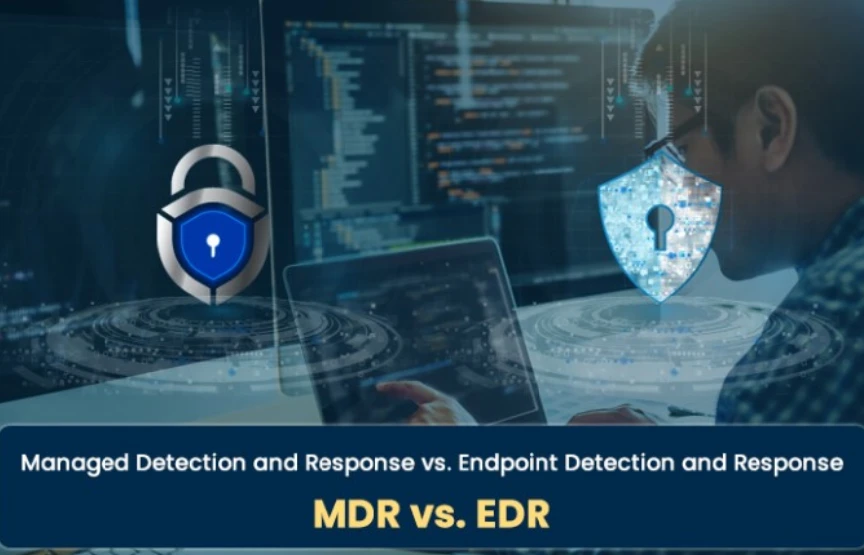How EDR Works: Endpoint Protection in Action
Endpoint Detection and Response (EDR) is a cybersecurity solution designed to monitor, detect, and respond to threats at the endpoint level. Endpoints, such as computers, mobile devices, and servers, are prime targets for cyber threats, making real-time security measures essential. EDR provides organizations with deep visibility into endpoint activities, enabling security teams to detect anomalies, investigate incidents, and mitigate risks before they escalate.
EDR operates by continuously collecting and analyzing data from endpoints to identify suspicious behavior. Unlike traditional antivirus solutions that rely on signature-based detection, EDR uses advanced techniques such as behavioral analysis, artificial intelligence (AI),and machine learning to identify unknown threats. This proactive approach allows EDR to detect sophisticated attacks, including zero-day threats and fileless malware, that traditional security tools might miss.
One of the key functions of EDR is threat detection. When a potential threat is identified, EDR solutions generate alerts and provide detailed insights into the nature of the threat, its origin, and how it spreads. This allows security teams to assess the risk and take necessary action. Many EDR platforms also offer automated response capabilities, enabling them to contain and remediate threats in real time without requiring manual intervention.
Incident investigation is another crucial aspect of EDR. Security analysts can use the forensic data collected by EDR to conduct root cause analysis and understand the full scope of an attack. By tracking the attacker’s movements and identifying vulnerabilities, organizations can strengthen their security posture and prevent future incidents.
EDR also plays a vital role in compliance and regulatory requirements. Many industries have strict security standards that require organizations to implement robust threat detection and response mechanisms. EDR provides the necessary logging and reporting capabilities to demonstrate compliance with frameworks such as GDPR, HIPAA, and NIST.
While EDR offers significant security benefits, it requires skilled personnel to manage alerts and respond to incidents effectively. Some organizations may struggle with resource constraints, leading them to consider alternative solutions such as Managed Detection and Response (MDR),which provides outsourced expertise. However, for businesses with in-house security teams, EDR serves as a powerful tool to detect, investigate, and neutralize threats at the endpoint level.
In summary, EDR enhances an organization’s ability to protect its endpoints by providing real-time monitoring, advanced threat detection, and automated response capabilities. By integrating EDR into their cybersecurity strategy, businesses can reduce their risk exposure and improve overall security resilience.
How MDR Works: Managed Detection & Response in Action
Managed Detection and Response (MDR) is a cybersecurity service that provides organizations with 24/7 threat detection, analysis, and response, managed by a team of security experts. Unlike Endpoint Detection and Response (EDR),which requires in-house security teams to monitor and act on alerts, MDR is an outsourced solution that combines advanced technology with human expertise to protect businesses from cyber threats.
MDR operates by continuously monitoring an organization’s IT environment, including endpoints, networks, and cloud assets, for signs of malicious activity. The service uses a combination of artificial intelligence, machine learning, and behavioral analytics to detect anomalies and potential threats that might go unnoticed by traditional security tools. By leveraging threat intelligence and real-time data analysis, MDR can quickly identify sophisticated cyberattacks, including ransomware, advanced persistent threats (APTs),and insider threats.
A key advantage of MDR is its proactive approach to threat hunting. Instead of waiting for alerts to be triggered, MDR analysts actively search for indicators of compromise (IoCs) and suspicious activity across an organization’s infrastructure. This proactive monitoring helps detect threats early, reducing the likelihood of a successful cyberattack.
When a threat is detected, the MDR team assesses its severity and takes immediate action to contain and neutralize it. Unlike automated security solutions that may only alert teams of potential issues, MDR provides expert-led investigation and guided remediation. Security analysts investigate attack vectors, analyze malware behavior, and determine the best course of action to mitigate risks. This hands-on approach ensures that threats are effectively managed without requiring organizations to have in-house security expertise.
Another important aspect of MDR is incident response and recovery. In the event of a security breach, MDR providers work closely with organizations to minimize damage, restore systems, and prevent future attacks. Many MDR services also include post-incident analysis, offering insights into how the attack occurred and what measures should be taken to strengthen security defenses.
MDR is particularly beneficial for businesses that lack dedicated cybersecurity personnel or advanced security infrastructure. Small and medium-sized businesses (SMBs) and enterprises with limited security resources often rely on MDR to gain access to top-tier security expertise without the costs of building an in-house security operations center (SOC).
In summary, MDR provides a comprehensive security solution by combining cutting-edge technology with human expertise to detect, analyze, and respond to cyber threats in real time. By outsourcing security operations to MDR providers, organizations can enhance their cybersecurity posture, reduce risks, and ensure continuous protection against evolving threats.
EDR vs MDR: Cost, Implementation, and Management
When evaluating Endpoint Detection and Response (EDR) vs. Managed Detection and Response (MDR), cost, implementation, and management are critical factors that organizations must consider. While both solutions enhance cybersecurity posture, they differ in pricing structures, deployment complexity, and operational management, making one more suitable than the other depending on a company’s resources and security needs.
Cost Considerations
EDR is typically more affordable from a licensing perspective since it is a software-based solution that is deployed on endpoints and managed in-house. However, while the initial cost of an EDR solution may seem lower, organizations must account for the hidden costs associated with hiring and training security personnel, managing alerts, and maintaining infrastructure. The total cost of ownership (TCO) increases if a company lacks an experienced security team to handle threat detection and response efficiently.
MDR, on the other hand, follows a subscription-based pricing model that covers technology, threat intelligence, and expert security analysts who manage the service. While MDR generally has a higher upfront cost, it eliminates the need for in-house cybersecurity hires, making it a cost-effective solution for companies that lack dedicated security teams. By outsourcing security operations, businesses can predict their cybersecurity costs more accurately and avoid unexpected expenses related to security breaches.
Implementation Complexity
Implementing EDR requires businesses to install security agents on endpoints, configure security policies, and integrate the system with existing security infrastructure. While many EDR solutions offer cloud-based management, deployment can be challenging for organizations without cybersecurity expertise. The time and effort required for proper setup, fine-tuning detection rules, and integrating EDR with security information and event management (SIEM) tools can add to the complexity.
MDR offers a more streamlined and hands-off implementation process. Since MDR providers handle security monitoring and response, they assist with deployment and configuration, ensuring optimal protection from day one. The implementation process typically involves integrating the organization’s security environment with the MDR provider’s Security Operations Center (SOC),allowing for continuous monitoring and threat detection without requiring in-house resources.
Ongoing Management
Managing an EDR solution requires an internal security team capable of monitoring alerts, investigating incidents, and responding to threats. While EDR provides valuable threat intelligence and forensic data, it does not automatically remediate threats. Security teams must analyze alerts, determine false positives, and take action to contain and eliminate threats. This can be resource-intensive, especially for businesses with a high volume of security alerts.
MDR shifts this responsibility to third-party security experts who monitor, analyze, and respond to threats in real time. The provider offers 24/7 monitoring, proactive threat hunting, and expert-led response, ensuring that security incidents are handled effectively without burdening the organization’s internal teams. MDR services also provide detailed reports and recommendations, allowing businesses to stay informed about their security posture while focusing on core operations.
Which is the Better Choice?
For organizations with in-house security expertise and resources, EDR provides greater control over cybersecurity operations. However, it requires significant investment in security personnel, training, and infrastructure. On the other hand, MDR is ideal for companies that lack dedicated security teams or require comprehensive threat detection and response without the complexity of managing it themselves. The choice between EDR and MDR ultimately depends on a company’s budget, security maturity, and risk tolerance.
Choosing The Right Cybersecurity Solution for Your Business
Selecting the right cybersecurity solution for your business is a critical decision that depends on various factors, including your organization's size, security expertise, budget, and risk tolerance. While both Endpoint Detection and Response (EDR) and Managed Detection and Response (MDR) provide robust threat detection and response capabilities, they serve different needs and require different levels of involvement from internal teams. Understanding these differences will help you make an informed decision that aligns with your security goals.
The first step in choosing between EDR and MDR is evaluating your organization’s cybersecurity requirements. Consider factors such as the current threat landscape, in-house security expertise, compliance obligations, and overall business risk. If your business operates in an industry with strict security regulations, such as healthcare or finance, having a strong incident detection and response strategy is essential. Additionally, organizations that frequently deal with sensitive customer data or intellectual property are at higher risk and require more advanced threat protection.
EDR is a suitable choice for businesses that have an internal security team capable of managing cybersecurity operations. It provides real-time visibility into endpoint activities, allowing security analysts to investigate threats, conduct forensic analysis, and respond to security incidents. However, EDR solutions generate a high volume of alerts, which require skilled professionals to interpret and act upon. If an organization lacks the resources to monitor and manage security alerts effectively, EDR may become overwhelming, leading to potential security gaps.
MDR, on the other hand, is a fully managed solution that provides 24/7 monitoring, proactive threat hunting, and expert-led response. It is ideal for organizations that do not have a dedicated security team or those looking to outsource their cybersecurity operations to a trusted provider. MDR eliminates the need for in-house expertise by offering continuous monitoring, advanced analytics, and incident response handled by a team of cybersecurity professionals. This allows businesses to focus on their core operations while ensuring that their digital assets remain protected.
Budget considerations also play a significant role in choosing between EDR and MDR. While EDR has a lower initial cost, it requires ongoing investment in personnel, training, and infrastructure to be effective. MDR, on the other hand, comes with a higher subscription-based pricing model but provides a comprehensive security service without requiring additional hires or technology investments. For small and medium-sized businesses (SMBs) or enterprises with limited security resources, MDR can be a cost-effective way to enhance cybersecurity defenses without the complexity of managing it in-house.
Ultimately, the choice between EDR and MDR depends on the specific needs and capabilities of your business. If you have an in-house security team with the expertise to manage threat detection and response, EDR can be a powerful tool to enhance your cybersecurity posture. However, if you require a hands-off approach with expert security analysts managing threats on your behalf, MDR offers a more complete and hassle-free security solution. Carefully assessing your organization's security maturity, operational needs, and budget will help determine the best cybersecurity solution to protect against evolving threats.






